Großdeutschland-Kaserne (110.Infanterie-Regiment)
After World War I, the Versailles Treaty of 1919 restricted the defeated German nation to a small self-defense force limited to not more than 100,000 personnel. The National Socialist regime came to power in January 1933 when Adolf Hitler became Chancellor. The new Government lost no time in taking steps to disregard what it perceived as unjustified terms of the 1919 treaty. In October 1933, Germany gave formal notice of its withdrawal from the League of Nations. In March 1935 compulsory military service was re-instated and a major buildup of the German armed forces began.
As part of the buildup, the 110th Infantry Regiment was activated in May 1936 and scheduled for stationing in Heidelberg. The existing Grenadier-Kaserne (now Patton Barracks) was not large enough to accommodate the regiment. Accordingly, a new installation was built in 1937 on what was then farmland on the southern outskirts of Heidelberg near the suburb of Rohrbach.
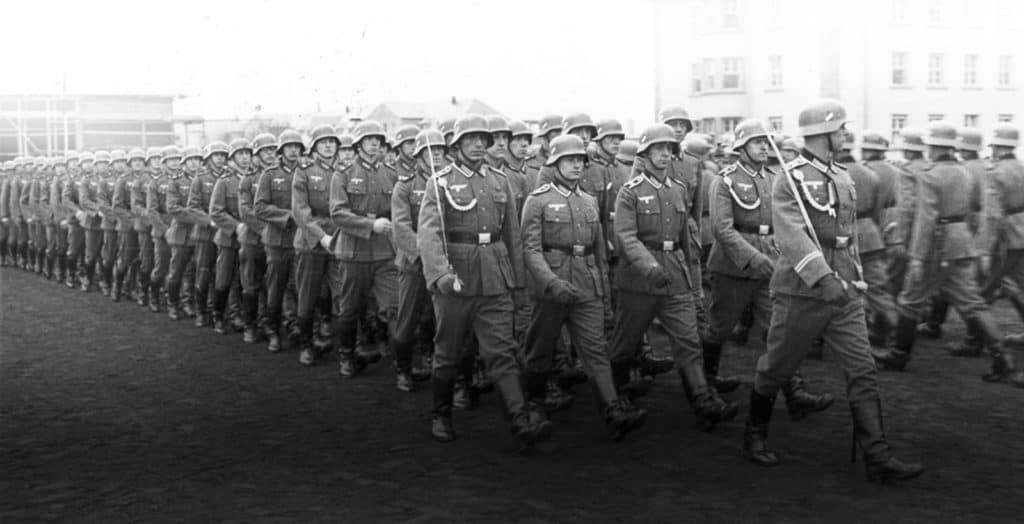
Heidelberg, Germany – November 1937
Origins of Großdeutschland-Kaserne
At first unnamed, the new installation was designated Großdeutschland-Kaserne after Austria became part of the German Empire in March 1938. Stories linking Großdeutschland-Kaserne to the Großdeutschland-Division of World War II have no foundation. The Kaserne predates the division, which was not formed until May 1942 when it was activated as an armored infantry (Panzer-Grenadier) division and later reorganized and redesignated an armored (Panzer) division. Neither the division nor any of its subordinate units were ever stationed in Heidelberg. The 110th Infantry Regiment was never assigned or attached to the Großdeutschland-Division.
When completed, the new Kaserne in Heidelberg became the home of the 110th Infantry Regiment’s headquarters, its 1st Battalion, and its two regimental support companies. The regiment’s 2d Battalion was stationed at Loretto-Kaserne (Hammonds Barracks) in Seckenheim and the 3d Battalion at Grenadier-Kaserne (Patton Barracks).
Großdeutschland-Kaserne Buildings
At Großdeutschland-Kaserne the regimental staff occupied the north wing of what is now building 7; the 1st Battalion staff had the south wing. Buildings 3 and 5 were the Kantine with a dining facility, recreation room, and a snack bar where troops could buy food and drink when off duty. The upper floors of buildings 3 and 5 provided living quarters for the staff of these facilities, usually retired career soldiers and their families.
The 1st, 2d, and 3d (rifle) Companies of the 1st Battalion were billeted in buildings 9, 13, and 8, respectively; the 4th (heavy weapons) Company in building 15; the 13th (cannon) Company in building 14; and the 14th (antitank) Company in building 12.
Building 31-south provided stables for the horses of the 1st Battalion staff and the 4th (heavy weapons) Company. Building 31-north had stables for the regimental staff and the 13th (cannon) Company. Building 16 contained quarantine stalls for sick and injured horses. Arms rooms were in buildings 28 and 37. The regimental blacksmith was in building 25. The section of building 31 connecting buildings 31-south and 31-north was a riding hall. The parking lot in front of the building was a riding ring. Building 18 was a drill hall. The parade ground to the west of building 7 has been a parade ground since the caserne was built.
Next to the entrances to most buildings on Campbell Barracks, representations of soldiers from various periods of German history are carved in the red sandstone.
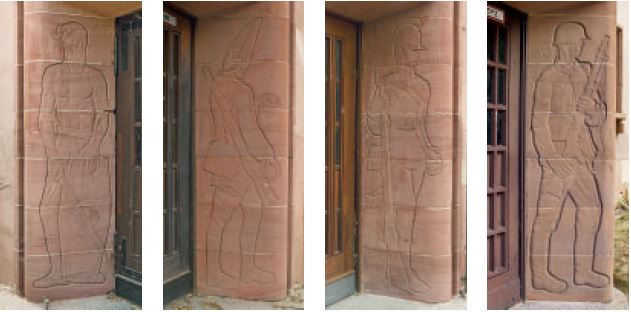
The four figures above the main gate to Campbell Barracks on Römerstraße symbolize key periods in German history. The figure on the left represents the first part of this century from World War I through the German Third Reich of the 1930s and early 1940s; the second from the left symbolizes the late 19th century, German unification, and the establishment of the German Second Empire of 1871; the second from the right is a Hessian dragoon of 1806; and the figure on the far right represents a Württemberg light infantryman (Jäger) of 1805.

Campbell Barracks – Keyes Building, Building 1
As can be seen in the 1948 aerial photograph of Campbell Barracks, the Keyes Building (building 1) originally was not part of the caserne. Building 1, which provided offices for the commanders in chief and chiefs of staff from 1948 to 2013, was named in honor of Lieutenant General Geoffrey Keyes, U.S. Army, on 17 January 1974. Lieutenant General Keyes served in Heidelberg as the commander of the Seventh Army from September 1945 to March 1946, and as Commander of the Third Army until 10 January 1947.
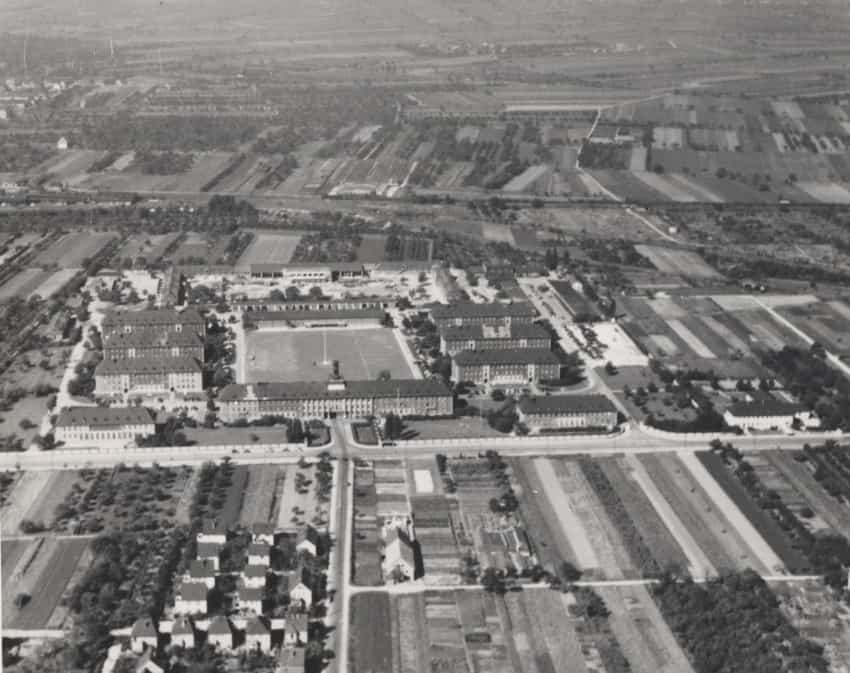
Until the end of World War II, the Keyes Building served as the regimental officers’ mess. What became the Keyes Building Conference Room was originally the officers’ ballroom.
The south wing of the Keyes Building, which housed the offices of the Commander in Chief, USAREUR, and Deputy Commander in Chief, USAREUR, was added to the original structure between May and September 1951 while General Thomas T. Handy was in command.
When the Seventh Army and USAREUR headquarters merged in December 1966, the second-floor suite in the south wing of the Keyes Building became the office of the Deputy Commander in Chief, USAREUR, and the office of the Chief of Staff, HQ USAREUR/7A, moved to the ground floor.
Historic Points of Interest
The Chief of Staff’s office has several points of interest that reflect its history as part of the original ballroom complex. On the west wall, for example, a large map is surrounded by wooden paneling. Originally this space had two large swinging doors that connected the room directly to the ballroom.
The wall above the fireplace on the north side is decorated with the arms of Kaiser Wilhelm I, the eagle of the German Empire, and the coats of arms of Heidelberg and Mannheim. The windows on the south side overlooking the patio are flanked by inlaid wooden panels showing scenes of the Mannheim and Heidelberg castles and the coats of arms of the two cities.
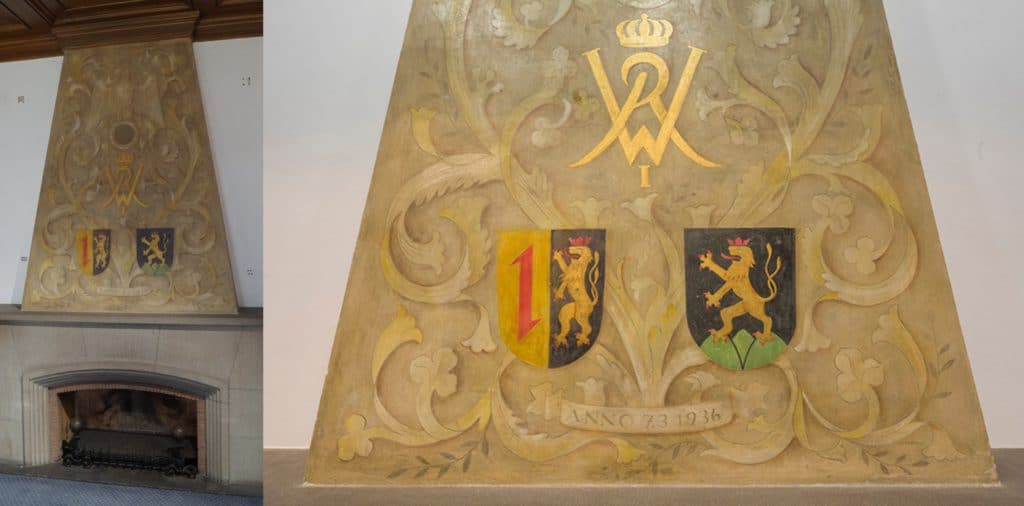
These coats of arms are also in the lead-glass windows of the building’s lobby. These windows were custom-made in 1938 by the Munich firm Werkstatt Firma Meyer. The figure on the left is a 13th-century knight. The words Für Minne (for Minne) proclaim this to be a knight of chivalry who fights in the name of the woman he loves. The right-hand panel shows a Landsknecht (a mercenary soldier of the 15th and 16th centuries) and the words Für Sold (for pay). The center panel shows a World War I soldier and the words Für Volk und Reich (for the people and for the empire). It would have had special significance to the National Socialists of the time, who had revived and given new meaning to the concepts of a German people and a German empire.

The chandeliers in the lobbies next to the Commander in Chief’s and Chief of Staff’s prior offices also date from 1938. The stairway leading to the basement has an interesting iron grill with a design of barrels, grapes, and wine glasses. The word Trinkstube (drinking room) was also inscribed, indicating that the original officers’ mess was used as a tavern.
The landscaped gardens around the Keyes Building with their majestic trees some 10 to 15 years older than the building itself, add to the building’s distinctive appearance.
History of the 110th Infantry Regiment
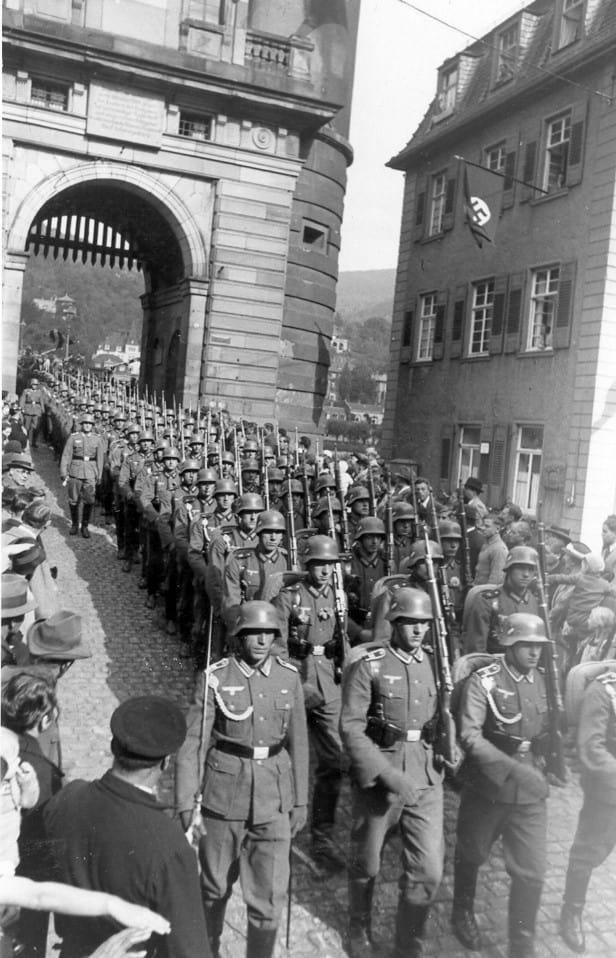
Heidelberg Old Bridge – October 7, 1937
Technically the dissolution of the German Empire after World War I marks a complete break in the traditions and lineage of the units that had served in the Imperial Army. Thus the 110th Infantry Regiment that was activated in May 1936 as part of the new Wehrmacht does not trace its lineage to any unit of the past.
A traditional attachment exists, however, between the city of Heidelberg and another infantry regiment that once bore the numerical designation 110.
Stained-glass windows in the anteroom to the Commander in Chief’s former office in the Keyes Building show the coats of arms of Baden, Bavaria, and Prussia, with inscriptions commemorating the 2d Line Infantry Regiment; the 2d Infantry Regiment (Prinz von Preußen) (Prince of Prussia); the 2d Infantry Regiment (König von Preussen) (King of Prussia); the 3d Battalion, 36th Infantry Regiment; and the 2d Battalion, 110th Infantry Regiment.
Similar windows in the former office of the executive officer to the Commander in Chief have stained-glass windows with the coats of arms of the cities of Durlach, Heidelberg, Konstanz, Mannheim, Speyer, and Wetzlar.
These windows date from the time the caserne was built as the home of the 110th Infantry Regiment. They testify to the new regiment’s allegiance to units from Germany’s past, despite there being no direct lineage. The windows provide a glimpse of the military history of southwestern Germany back to the mid-19th century.
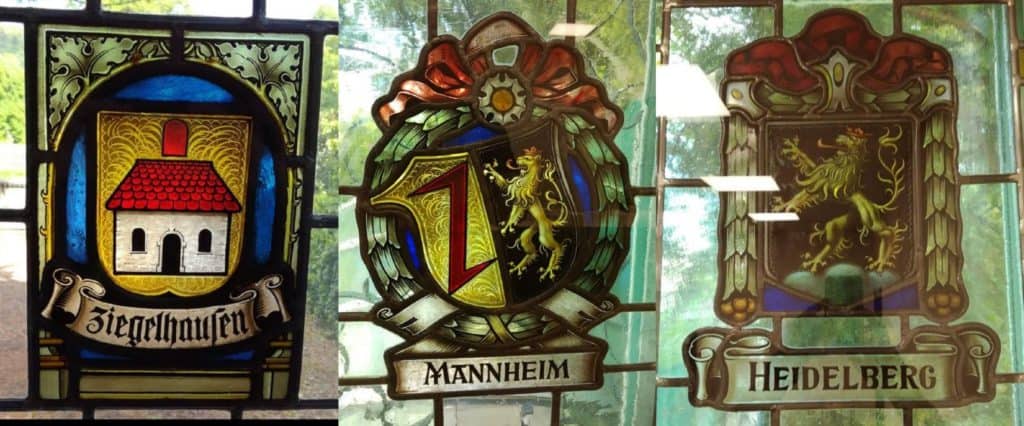
110.Infanterie-Regiment Organizational Timeline
After the revolutions of 1848, the army of the Grand Duchy of Baden was organized with ten separate battalions. On 22 October 1852, the Baden army was reorganized into four 2-battalion regiments and two separate battalions. The former 4th and 7th Battalions were merged with the 2d Line Infantry Regiment and designated as the 1st and 2d Battalions of the regiment, which was stationed at Rastatt where today the ducal palace houses the German Army Museum (Wehrgeschichtliches Museum).
In September 1856, Grand Duke Friedrich of Baden married Princess Luise, daughter of Prince Wilhelm of Prussia. The following year, on 9 August 1857, the Grand Duke made his father-in-law chief of the regiment and named it the 2d Infantry Regiment, Prinz von Preußen. The prince was an honorary colonel of the regiment while a regular army colonel commanded it. The regiment moved to Mannheim in 1857. In 1859, the regiment again moved, this time to Konstanz on the Bodensee (Lake Constance). When King Friedrich Wilhelm IV died on 5 January 1861, Prince Wilhelm ascended the Prussian throne as King Wilhelm I, whereupon the regiment was redesignated the 2d Infantry Regiment, König von Preußen. After the Seven Weeks War between Austria and Prussia (June through August 1866), the regiment was again stationed in Mannheim.
In 1867, a third battalion was added to the regiment. The headquarters of the 1st and 2d Battalions remained in Mannheim, while the 3d Battalion was stationed in Durlach near Karlsruhe. The following year, the 3d Battalion moved to Mannheim and the 2d Battalion moved first to Rastatt, then to Durlach.
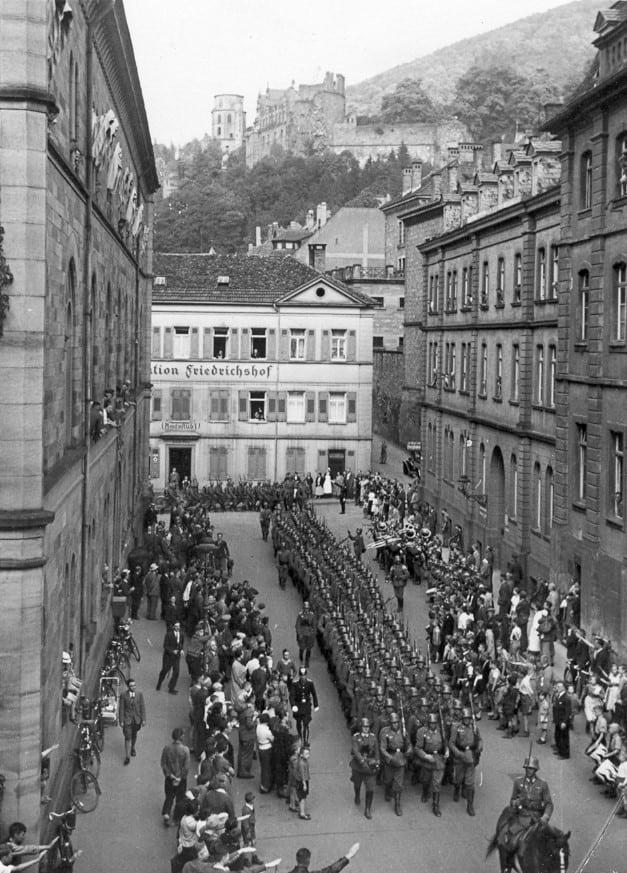
Led by Battalion Commander Lieutenant Colonel Gümbel
Heidelberg, Germany (Schloss Heidelberg in the background)
As a result of the regiment’s fine performance in the annual fall maneuvers, the Grand Duke once more redesignated the regiment on 9 September 1869 (the Duke’s birthday) as the 2d Grenadier Regiment, König von Preußen.
After German unification and the creation of the Second Empire, King Wilhelm of Prussia was formally proclaimed Emperor (Kaiser) Wilhelm I on 18 January 1871. Thereafter the regiment was again renamed on 2 April 1871 as the 2d Baden Grenadier Regiment, Kaiser Wilhelm I, Nr. 110.
Late in 1880, another re-stationing was directed. On 31 March 1881, the 2d Battalion, 2d Baden Grenadier Regiment, Kaiser Wilhelm I, Nr. 110, arrived in Heidelberg. This established the ties between Heidelberg, the regiment, and the units from the Baden Army that preceded it. The regimental headquarters and its 1st and 3d Battalions remained in Mannheim.
Wilhelm died on 9 March 1888 and was succeeded by his son who became Kaiser Friedrich III. Friedrich was already fatally ill when he ascended the throne and died on 15 June 1888. Friedrich was succeeded by his son who became Kaiser Wilhelm II. More than 5 years later, Kaiser Wilhelm II took the title of regimental chief on 14 September 1893. The name of the regiment was not changed.
After World War I, the Imperial German Army was disbanded and replaced by a small self-defense force, the Reichswehr, which was limited to 100,000 men. As part of the buildup of the new Wehrmacht under the National Socialist regime, a new 110th Infantry Regiment was formed in 1936 with three battalions. One of these was made up of Bavarian State Police (Landespolizei) converted to Army personnel; another was similarly organized with members of the Baden State Police; and the third was organized around the core of a company of the 3d Battalion, 36th Infantry Regiment, transferred from Wetzlar and redesignated. The formal entry of the regiment into Heidelberg was marked on 7 October 1937 with a march through the city.
110.Infanterie-Regiment During WW2
As part of the 33d Infantry Division, the 110th Infantry Regiment fought in the 1940 campaign against France. The conflict resulted in 7 officers and 189 enlisted members of the regiment being killed, 11 officers and 493 enlisted being wounded, and 1 officer and 26 enlisted declared missing.
After withdrawing from France in the fall of 1940, the 33d Infantry Division was reorganized as an armored division and the 110th Infantry Regiment was transferred to the 112th Infantry Division. The regiment then fought on the Eastern Front on 26 July 1941 at Stary Bychow on the Dniepr River. By February 1944 the regiment had been reduced to a battalion-size battle group (Regimentsgruppe). After the battle at Tscherkassy and the breakout from the encirclement on 18 and 19 February 1944, what remained of the 112th Infantry Division was re-organized in early April as the 110th Grenadier Regiment to become the 1st Battalion. The survivors of the 110th Infantry Regiment became the 2d Battalion of the reorganized 110th Grenadier Regiment. The remaining personnel of the divisional units were formed into the regimental headquarters and headquarters company and the 13th (cannon) and 14th (antitank) Companies.
In its reduced size, the regiment remained in action through the summer and fall of 1944. It was decimated during the winter retreat of 1944 to 1945. By mid-February 1945, the regiment was so reduced in strength that its remnants were assigned to other units. Ultimately, the regiment itself was dropped from the rolls of the German army.
